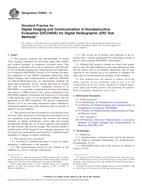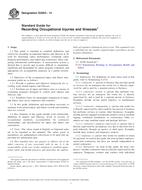Potrebujeme váš súhlas na využitie jednotlivých dát, aby sa vám okrem iného mohli ukazovať informácie týkajúce sa vašich záujmov. Súhlas udelíte kliknutím na tlačidlo „OK“.
ASTM E1931-09
Standard Guide for X-Ray Compton Scatter Tomography
Automaticky preložený názov:
Štandardné príručka pre X-Ray Compton Scatter tomografia
NORMA vydaná dňa 1.6.2009
Informácie o norme:
Označenie normy: ASTM E1931-09
Poznámka: NEPLATNÁ
Dátum vydania normy: 1.6.2009
Kód tovaru: NS-43635
Počet strán: 13
Približná hmotnosť: 39 g (0.09 libier)
Krajina: Americká technická norma
Kategória: Technické normy ASTM
Kategórie - podobné normy:
Anotácia textu normy ASTM E1931-09 :
Keywords:
back-scatter, compton scatter tomography, computed tomography, CST, radiologic, radioscopic, slice image, tomography, CST (Compton scatter tomography), Image analysis, Radioisotopes, Radiological examination, Slice image, Tomography, X-ray Compton scatter tomography (CST), ICS Number Code 35.240.80 (IT applications in health care technology)
Doplňujúce informácie
| Significance and Use | ||||||||||||||||
|
Principal Advantage of Compton Scatter Tomography—The principal advantage of CST is the ability to perform three-dimensional X-ray examination without the requirement for access to the back side of the examination object. CST offers the possibility to perform X-ray examination that is not possible by any other method. The CST sub-surface slice image is minimally affected by examination object features outside the plane of examination. The result is a radioscopic image that contains information primarily from the slice plane. Scattered radiation limits image quality in normal radiographic and radioscopic imaging. Scatter radiation does not have the same detrimental effect upon CST because scatter radiation is used to form the image. In fact, the more radiation the examination object scatters, the better the CST result. Low subject contrast materials that cannot be imaged well by conventional radiographic and radioscopic means are often excellent candidates for CST. Very high contrast sensitivities and excellent spatial resolution are possible with CST tomography. Limitations—As with any nondestructive testing method, CST has its limitations. The technique is useful on reasonably thick sections of low-density materials. While a 25 mm (1 in.) depth in aluminum or 50 mm (2 in.) in plastic is achievable, the examination depth is decreased dramatically as the material density increases. Proper image interpretation requires the use of standards and examination objects with known internal conditions or representative quality indicators (RQIs). The examination volume is typically small, on the order of a few cubic inches and may require a few minutes to image. Therefore, completely examining large structures with CST requires intensive re-positioning of the examination volume that can be time-consuming. As with other penetrating radiation methods, the radiation hazard must be properly addressed. |
||||||||||||||||
| 1. Scope | ||||||||||||||||
|
1.1 Purpose—This guide covers a tutorial introduction to familiarize the reader with the operational capabilities and limitations inherent in X-ray Compton Scatter Tomography (CST). Also included is a brief description of the physics and typical hardware configuration for CST. 1.2 Advantages—X-ray Compton Scatter Tomography (CST) is a radiologic nondestructive examination method with several advantages that include: 1.2.1 The ability to perform X-ray examination without access to the opposite side of the examination object; 1.2.2 The X-ray beam need not completely penetrate the examination object allowing thick objects to be partially examined. Thick examination objects become part of the radiation shielding thereby reducing the radiation hazard; 1.2.3 The ability to examine and image object subsurface features with minimal influence from surface features; 1.2.4 The ability to obtain high-contrast images from low subject contrast materials that normally produce low-contrast images when using traditional transmitted beam X-ray imaging methods; and 1.2.5 The ability to obtain depth information of object features thereby providing a three-dimensional examination. The ability to obtain depth information presupposes the use of a highly collimated detector system having a narrow angle of acceptance. 1.3 Applications—This guide does not specify which examination objects are suitable, or unsuitable, for CST. As with most nondestructive examination techniques, CST is highly application specific thereby requiring the suitability of the method to be first demonstrated in the application laboratory. This guide does not provide guidance in the standardized practice or application of CST techniques. No guidance is provided concerning the acceptance or rejection of examination objects examined with CST. 1.4 Limitations—As with all nondestructive examination methods, CST has limitations and is complementary to other NDE methods. Chief among the limitations is the difficulty in performing CST on thick sections of high-Z materials. CST is best applied to thinner sections of lower Z materials. The following provides a general idea of the range of CST applicability when using a 160 keV constant potential X-ray source:
The limitations of the technique must also consider the required X, Y, and Z axis resolutions, the speed of image formation, image quality and the difference in the X-ray scattering characteristics of the parent material and the internal features that are to be imaged. 1.5 The values stated in both inch-pound and SI units are to be regarded separately as the standard. The values given in parentheses are for information only. 1.6 This standard does not purport to address all of the safety concerns, if any, associated with its use. It is the responsibility of the user of this standard to establish appropriate safety and health practices and to determine the applicability of regulatory limitations prior to use. |
||||||||||||||||
| 2. Referenced Documents | ||||||||||||||||
|
Podobné normy:
Historická
1.3.2013
Historická
15.12.2013
Historická
15.12.2013
Historická
15.12.2013
Historická
1.11.2013
Historická
1.1.2014



 ASTM E2553-07(2013)..
ASTM E2553-07(2013).. ASTM E2699-13
ASTM E2699-13 ASTM E2738-13e1
ASTM E2738-13e1 ASTM E2767-13
ASTM E2767-13 ASTM E2891-13
ASTM E2891-13 ASTM E2920-14
ASTM E2920-14
 Cookies
Cookies
